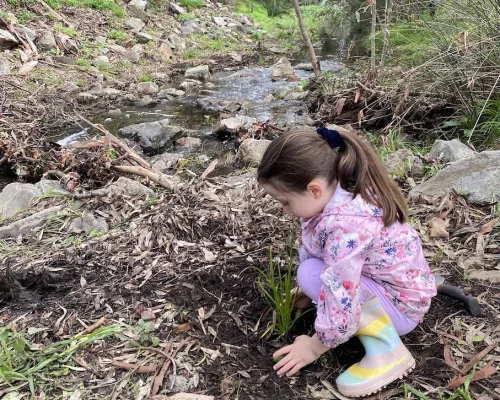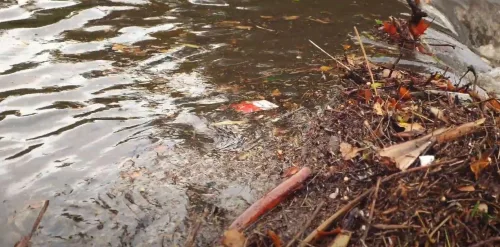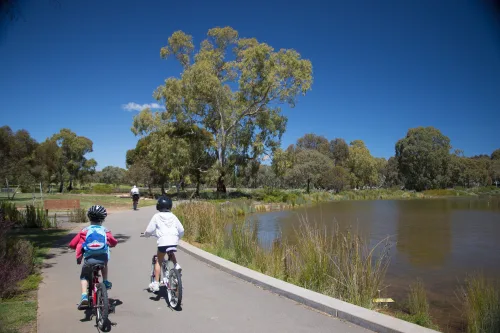Adelaide’s creeks, rivers and wetlands provide benefits for people, plants and animals – and the healthier they are, the greater the benefits. The actions you take in and around your property can impact our waterways. Discover how you can help keep our waterways healthy.
Why are healthy waterways important?
Urban waterways are one of the few remaining natural landscapes in our environment that can support a diverse range of native plants and animals. Here in Adelaide, our waterways are home to 244 species of birds, 27 mammals, 47 reptiles, 13 freshwater fish and 7 frog species.
Natural areas along waterways provide food, water and shelter for these animals and form wildlife corridors, allowing them to move between patches of habitat that would otherwise be isolated from each other.
The benefits are not just for our native animals though – healthy waterways help purify stormwater and move it out to sea. But this means that anything that happens upstream – at the source of the water and what it collects along the way – impacts everything along it and the coast.
What makes a healthy waterway?
Healthy waterways can be expected to have:
- stable and intact bed and banks with minimal erosion
- a channel free of major obstructions allowing water to flow downstream
- clean, mostly clear water free from excessive sediment, algae, rubbish and odour
- a good cover of dense and diverse native vegetation
- cool water temperature (the higher the temperature the less oxygen available for aquatic animals)
- thriving native wildlife populations.
What are common waterway problems?
Developments on or near waterways and unchecked stormwater runoff are among the many things that can negatively impact our creeks, rivers and wetlands, and can result in flooding or impacts on wildlife.
Typical problems include:
- an increase or decrease in the volume of flow or changes to the timing, duration and seasonal pattern of flows
- unstable, slumping, cracking and eroding banks
- barriers such as fences, walls, weirs, thick vegetation or fallen trees that block or change the water’s natural movement
- excessive soil build up from bank erosion that fills the waterway and reduces its ability to carry floodwaters
- excess nutrients in the water from fertiliser, leaf debris from exotic trees, and dog poo
- algal growth due to lack of shade and warm water temperatures
- pollutants such as pesticides, oil, grease, metals, dumped yard waste and construction debris
- unsuitable type or location of trees and vegetation.
Who is responsible for waterways?
Waterways can be located on land owned by individuals, businesses, on property boundaries, within an easement across a property, or in public parks or reserves. Property owners have legislative responsibilities to maintain waterways under the Landscape SA Act 2019 (the LSA Act), particularly when undertaking any work in or near a waterway, or on its banks or floodplains.
This includes ensuring the waterway is in good condition, water flow can continue through and downstream of the property and that reasonable measures are taken to prevent damage to beds, banks and to the ecosystems that depend on the waterway.
Owners of land adjoining or including an urban waterway are required to conduct maintenance and repairs to their section of waterway, and have legal responsibilities regarding Aboriginal Heritage when carrying out works on or around waterways.
Do I need approval to do work near a waterway?
You may need approval to undertake certain activities on or near creeks, rivers, wetlands and other waterways, as some things can have negative impacts on their health or condition, and the plants and animals that rely on them.
Green Adelaide regulates water resources in its region, including managing activities that may impact local watercourses through issuing Water Affecting Activity Permits.
Tips for managing works around waterways
When you need to undertake works on or around the waterway on your property consider the following:
- Be sure works do not constrict or limit the waterway channel. • Seek advice from qualified professionals if you have a problem along your waterway as actions you take may have consequences up and downstream.
- Undertake works during low flow periods (October to March) to give erosion control and stabilisation works the best chance of success.
- Where possible work with neighbours up and downstream to develop a coordinated approach to maintenance and repair.
- Take before and after photos, then adjust your maintenance or repair work when you see how your waterways responds.
- Ensure erosion control works take place before re-vegetating near a waterway.
Help look after Adelaide's waterways
We work with individuals and councils to protect Adelaide’s creeks, rivers and wetlands, but there’s a lot that you can do to help too – whether you own or rent a property with a waterway running through it, or have one nearby. All water ends up somewhere, so even if you live nowhere near a waterway, you can still play a part.
Here are some things to consider – especially if you have a waterway on or near your property:
- Be mindful when building structures, as bridges, sheds, retaining walls, decks and pipes – to name a few things – can change water flows.
- Keep waterways clear of debris, such as sediment, rubbish and even fallen leaves and grass clippings.
- Prevent and control erosion along waterway beds and banks by minimising activities on them and creating a buffer zone of the right vegetation.
- Minimise the amount of stormwater runoff going directly into a waterway by directing all gutters or downpipes to a rainwater tank, and reducing paved areas and other hard surfaces.
Soaps, chemicals and other home and garden items can negatively impact plants, animals and water quality. Here’s how everyone keep pollutants like these out of our waterways:
- Avoid or minimise the use of fertilisers, herbicides, and pesticides.
- Wash your car or equipment on a grassy or gravel area to avoid soaps (even the biodegradable ones) ending up in the gutter.
- Cover any exposed piles of construction material or soil.
- Collect any fallen leaves and put them in the green bin.
- Pick up rubbish on the street and in parks where safe to do so.
- Choose local native species for your garden, as they naturally filter water.
Check out our resources below for more detailed information on looking after waterways.






